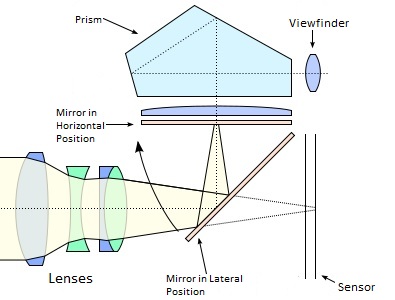Optical Imaging Systems
keyword: ECE 637, digital image processing
This section is on Lecture 4 of the series and covers Optical Imaging Systems. You can watch the unedited video here. Professor Bouman's Course notes on this topic can be found here.
Sub-Topics
The lecture provides an overview of digital imaging systems, digital cameras and lenses. Images are typically captured via optical imaging systems, particularly cameras. The figure below describes the mechanism behind how an image is captured in a Single Length Reflex (SLR) camera.
As you point your camera at an object and look through the viewfinder, light from the object passes through the lens and is incident on the mirror, which is positioned laterally so as to reflect the light trough the prism and into the viewfinder. Once you click to take a picture, the aperture closes and the mirror moves to the horizontal position shown in the figure. Next, the aperture reopens for the amount of time specified by the mode you have your camera set to. This time the light passing through the lens is incident upon the light sensor. In a DSLR, the information from the sensor is digitized and stored in local memory. Once this is completed, the mirror moves back to the lateral position and you can view objects through the viewfinder again.
The key item in the design of a camera is the lens so I have divided the rest of the notes into the following sub-topics:


